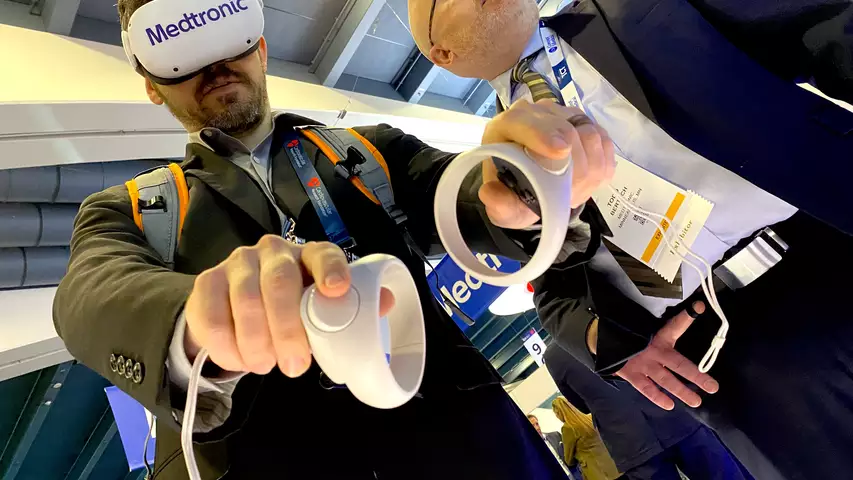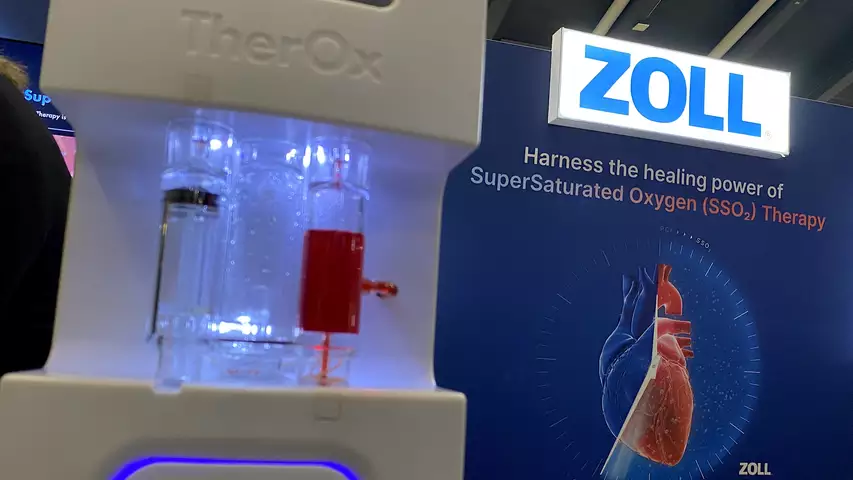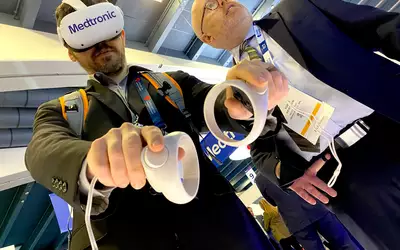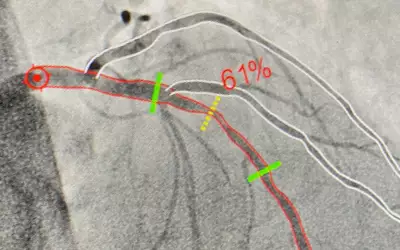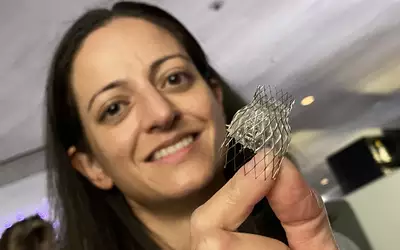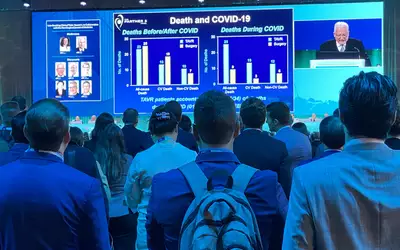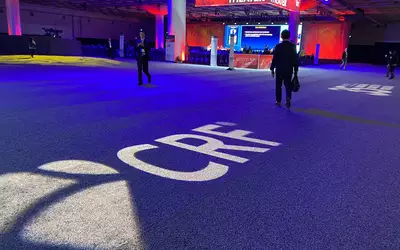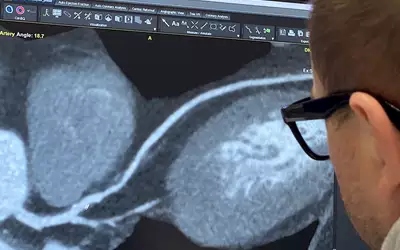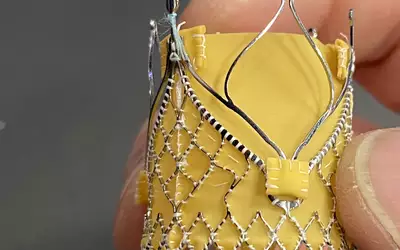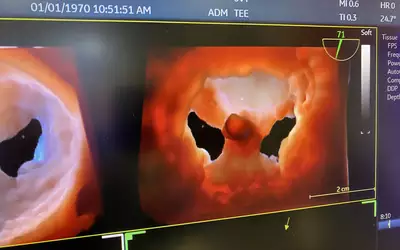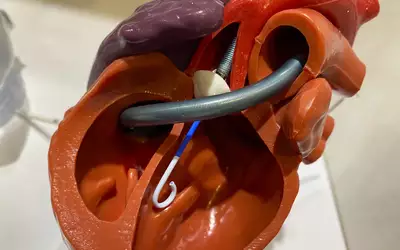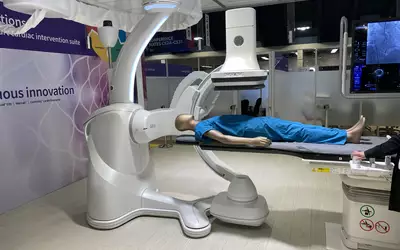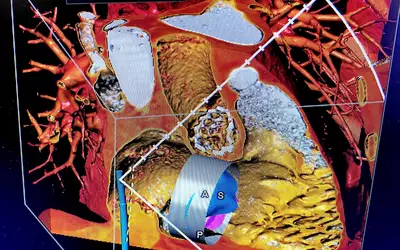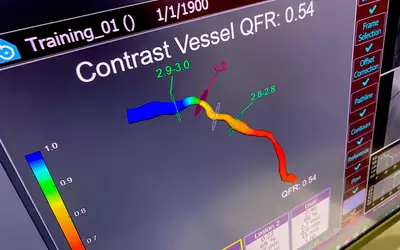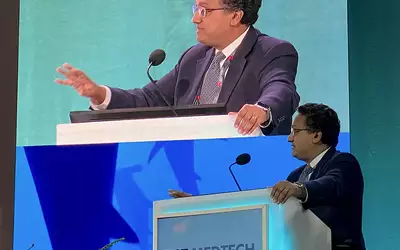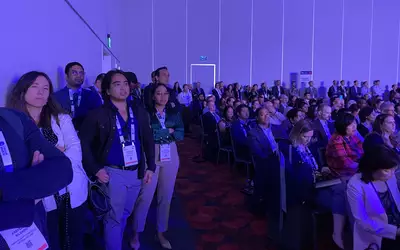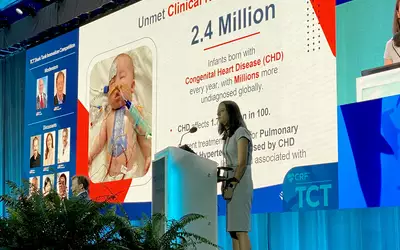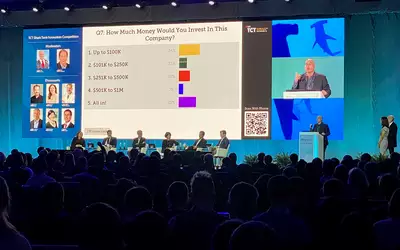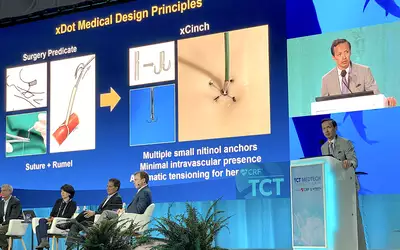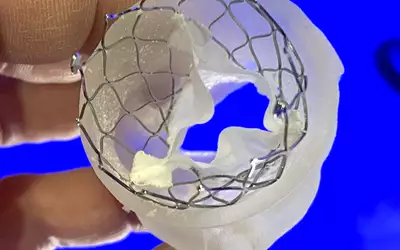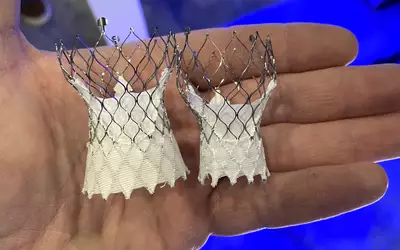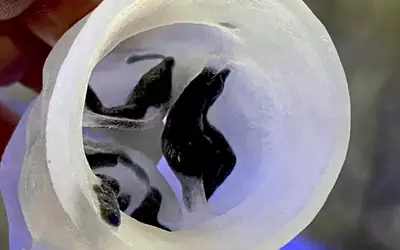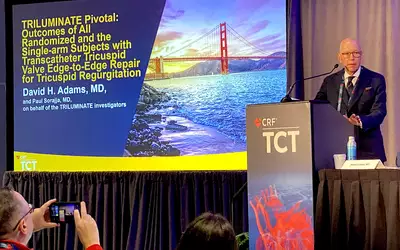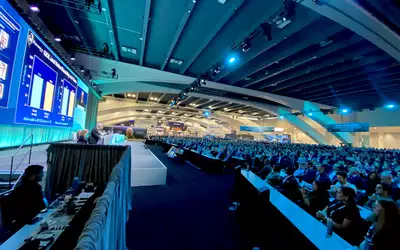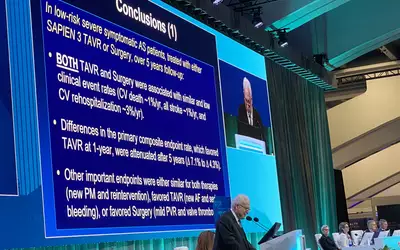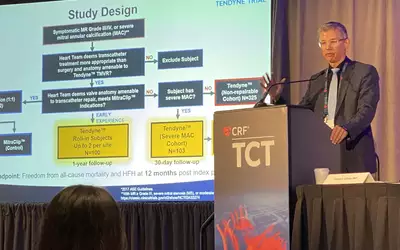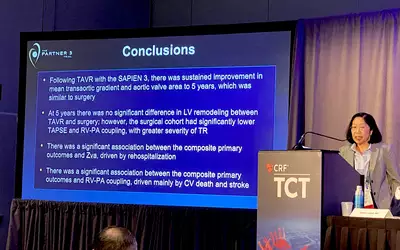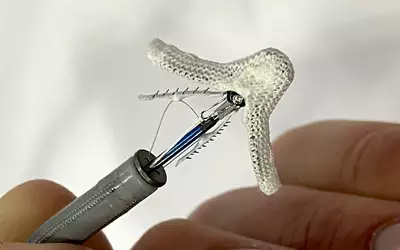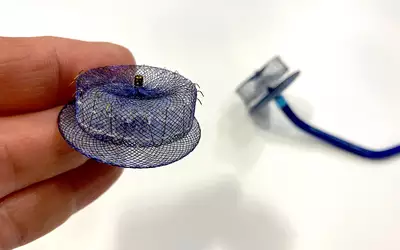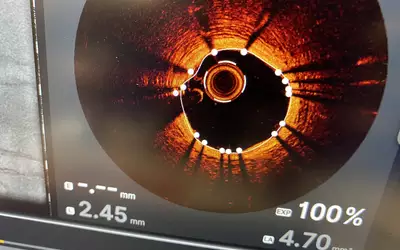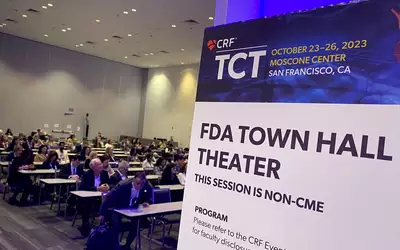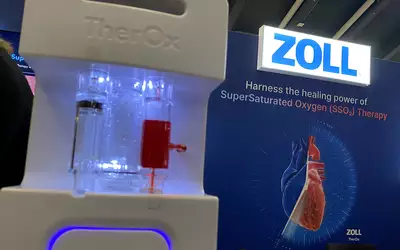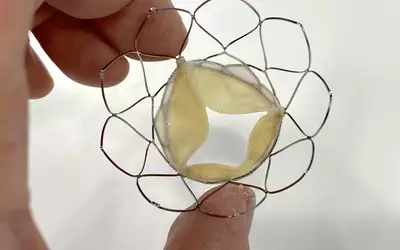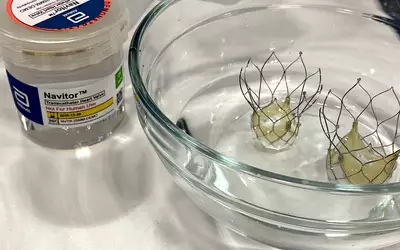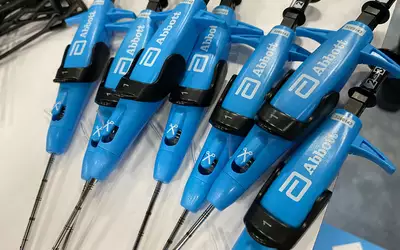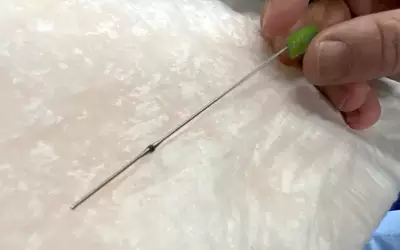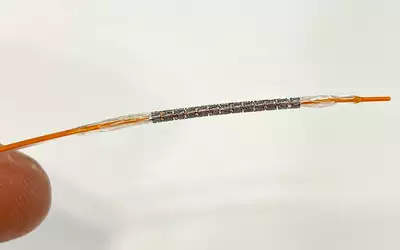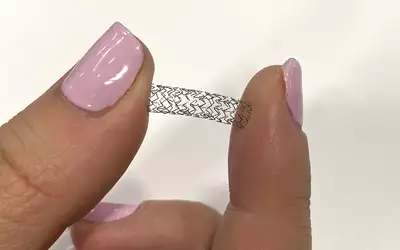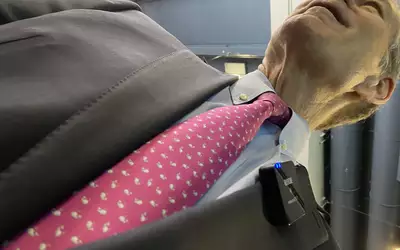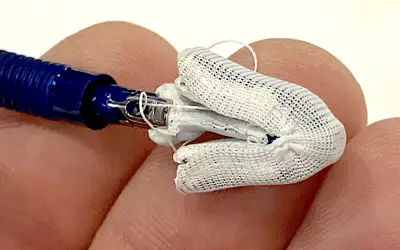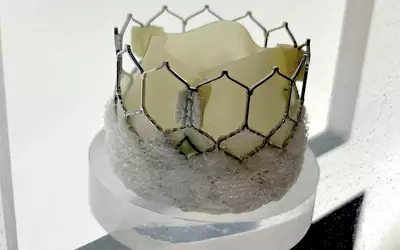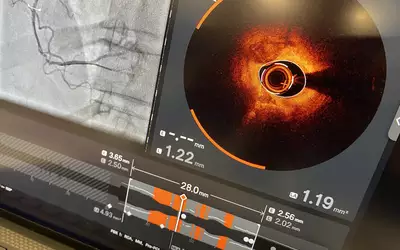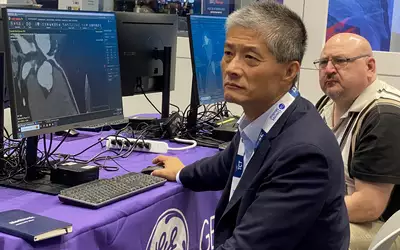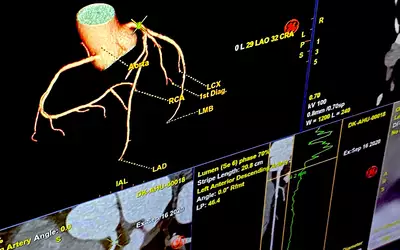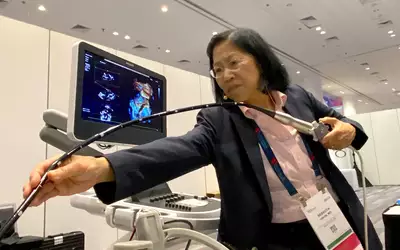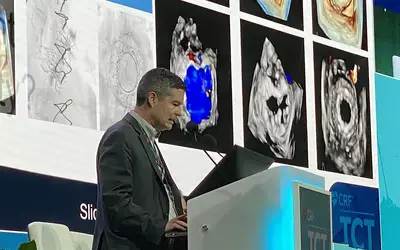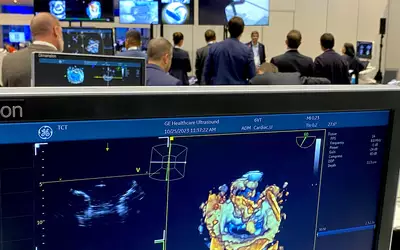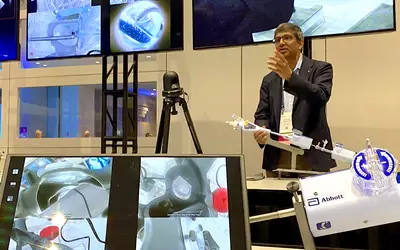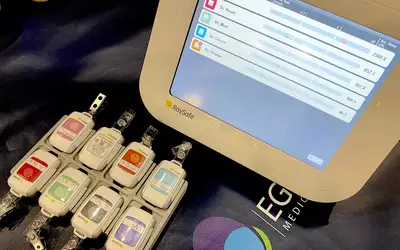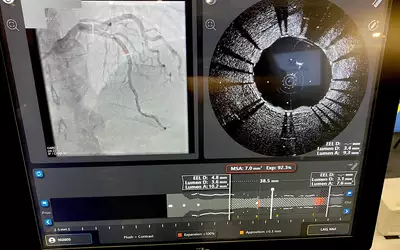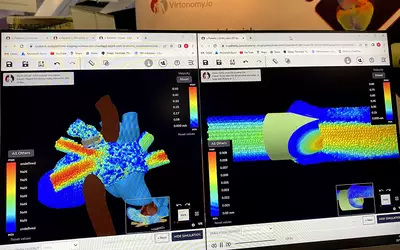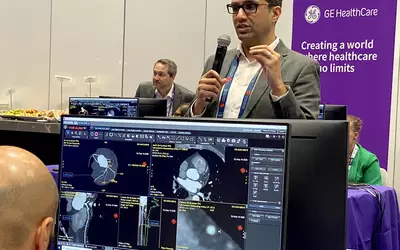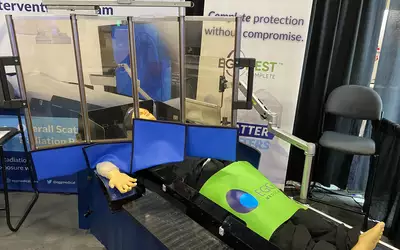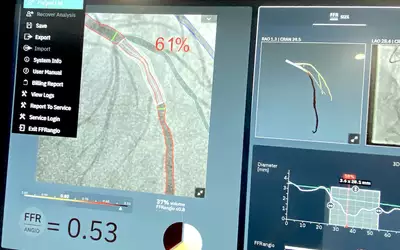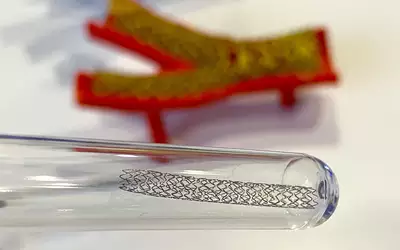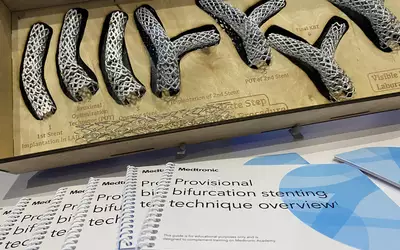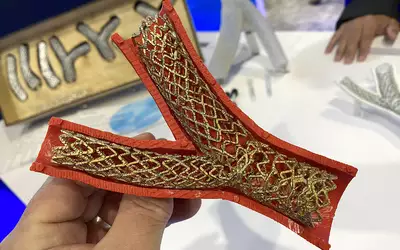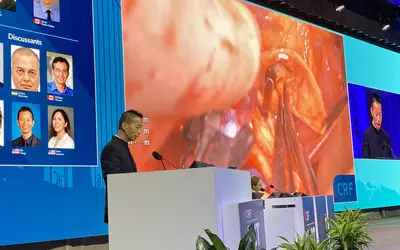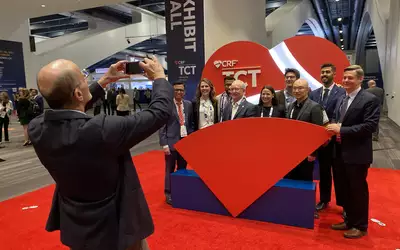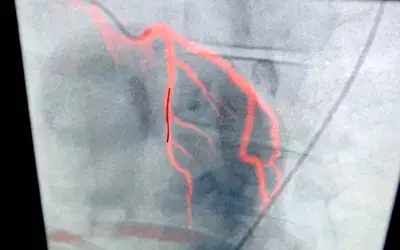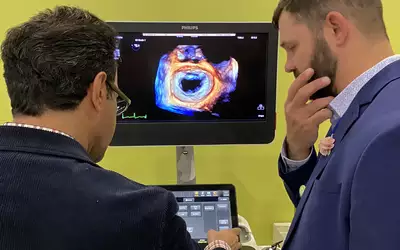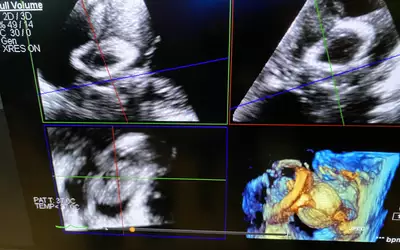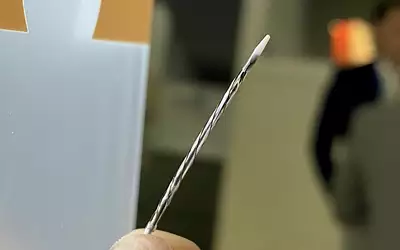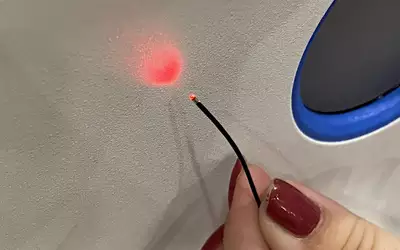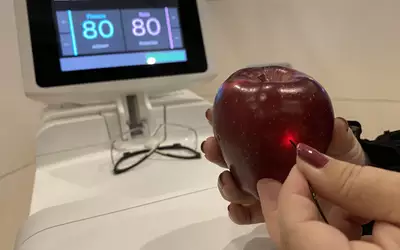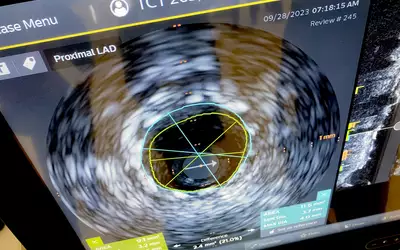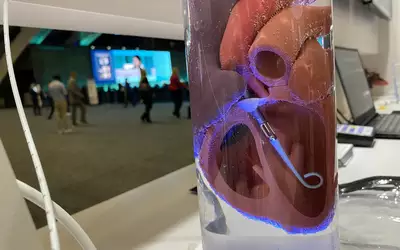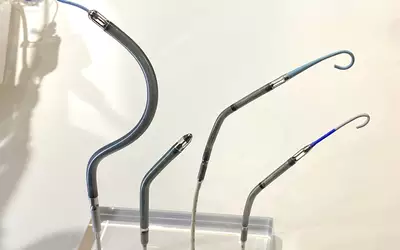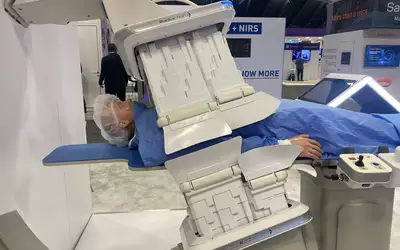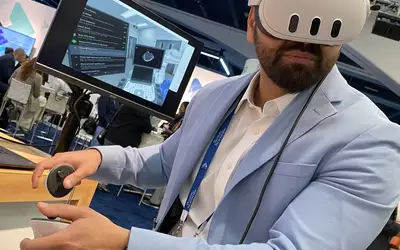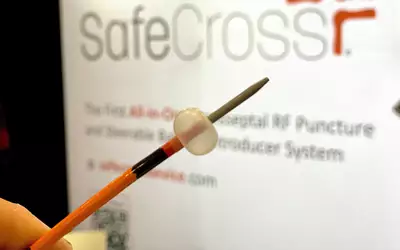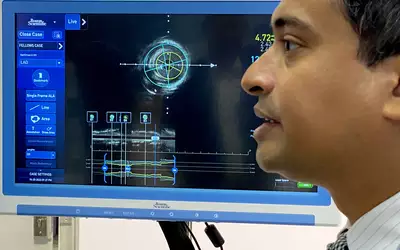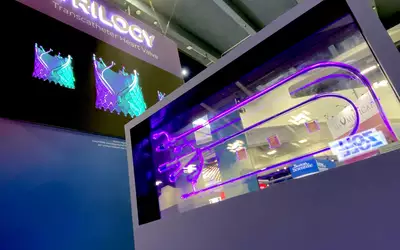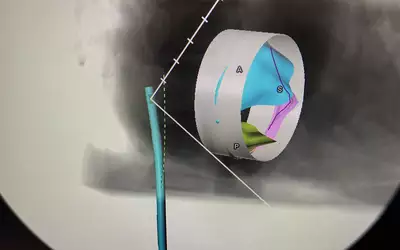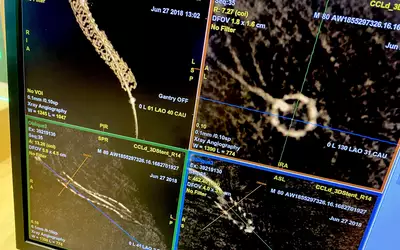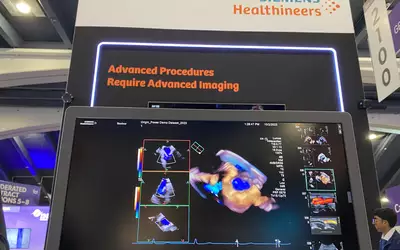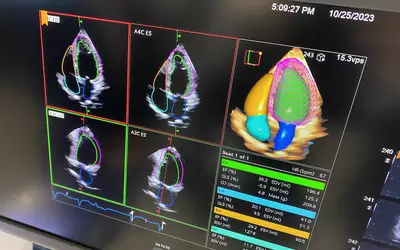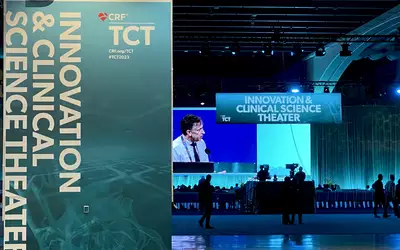PHOTO GALLERY: Interventional cardiology technologies at TCT 2023
Browse through our visual overview of some of the highlights and new technologies featured at TCT 2023, which took place Oct. 23-26, 2023, in San Francisco. The show focused on percutaneous coronary intervention (PCI), structural heart disease and peripheral vascular interventions.
TCT, organized by the Cardiovascular Research Foundation (CRF), is the largest interventional cardiology conference in the world.
CathWorks demonstration of its FFR-Angio vessel assessment technology fused with fluoroscopy to help interventional cardiologists in determining if a stent is needed and if so, provides information for the stent diameter and length. The technology works using a rotational angiography spin of the C-arm around the patient to create a 3D coronary segment that is color coded by FFR flow. This is then translated into the data fused with the image here.
Elena Amin, MBChB, a pediatric cardiologist with UCSF Health, shows off the HeartPoint Global IntelliStent to treat congenital pulmonary artery hypertension (PAH). The device won the TCT 2023 Shark Tank innovation competition. Read more in the article New pediatric interventional device for PAH wins ‘Shark Tank’ event at TCT 2023.
Martin Leon, MD, presents the PARTNER 3 low-risk transcatheter aortic valve replacement (TAVR) 5-year results, which was the most impactful late-breaking trial at TCT 2023. It was standing room only at this and the following presentation of the Evolut Low-Risk TAVR 4-year results. Both trials showed TAVR is low-surgical risk patients performed as well as surgical aortic replacement (SAVR), and in some data points TAVR was better than SAVR. These trials may pave the way for TAVR as a front-line procedure in most older patients in the years to come. Read more.
A coronary computed tomography angiography (CCTA) hands-on training session for interventional cardiologists to learn how to create curved planar views and analyze soft plaques. The GE Healthcare session at TCT 2023 was designed to give interventional cardiologists a better understanding of how to use cardiac CT, since its use is rapidly rising and the image datasets have a lot of value for preplanning PCI procedures.
A closeup view of the JenaValve Trilogy transcatheter aortic valve replacement (TAVR) valve designed specifically to treat aortic regurgitation in non-stenotic valves. This device was discussed in the positive late-breaking trial ALIGN-AR at TCT 2023. The currently cleared TAVR valves are all designed for use in calcified native valves as a stable anchoring point. But in valves without heavy calcium, a TAVR valve needs to be anchored to the soft tissue to prevent embolization. The Trilogy has three nitinol clips that grasp the native leaflets during deployment to secure the device to the valve annulus. There was a lot of excitement about this new device at TCT, which will allow AR patients to be treated without open heart surgery. Read more.
View of a MitraClip after capture of both mitral valve leaflets using the HD Live surgical view imaging feature on the GE Vivid e95 echocardiography system. Read more on advances in structural heart echo imaging.
GE Healthcare's newest angiography system, the Allia IGS, on display at TCT 2023. Its laser-guided, free-rolling gantry can be parked out of the way and does not require any floor or ceiling mounting. It includes integrations with the wireless Vscan Air POCUS ultrasound for use in vascular access and 3D Stent imaging reconstruction from rotational angiography, and allows the operator to change overhead screen layouts using table side controls.
Transcatheter tricuspid valve planning on CT scans using the 3mensio CAAS software at TCT 2023. The software allows placement of different sized valve shapes to determine sizing and how it will sit within the anatomy. The software also has planning tool for where to place TEE probes to get optimal imaging.
Medis QFR FFR-angio vessel assessment technology showing a 3D coronary segment that is color coded by FFR flow. This can help interventional cardiologists in determining if a stent is needed. The technology works using a rotational angiography spin of the C-arm around the patient and does not require FFR pressure wires.
Sahil Parikh, MD, of Columbia, one of the co-directors for the 2023 TCT meeting, presents at the TCT Shark Tank competition during TCT 2023. Parikh is an expert in peripheral interventions, including critical limb ischemia, renal stenting, carotid stenting, and treatment of pulmonary embolism. All of these areas are growing areas of interest at TCT.
Elena Amin, MBChB, a pediatric cardiologist with UCSF Health, presented her case for why the HeartPoint Global IntelliStent to treat pulmonary artery hypertension (PAH) is a unique device and can fill a void in therapies for congenital heart disease. The device won the TCT 2023 Shark Tank innovation competition. Read more in the article New pediatric interventional device for PAH wins ‘Shark Tank’ event at TCT 2023.
David Adams, MD, a cardiac surgeon with Mt. Sinai, speaks at a late-breaking clinical trial press conference on the results of the TRILLUMINATE trial at TCT 2023. Hear more about this trial.
Rebecca Hahn, MD, presents the PARTNER 3 low-risk transcatheter aortic valve replacement (TAVR) trial 5-year echocardiography results during a press conference at TCT 2023. This was the second part of the what turned out to be the most impactful late-breaking trial at TCT 2023. Read more.
Optical coherence tomography (OCT) intravascular imaging showing stent struts are well apposed to the vessel wall after stent expansion to avoid complications from malapposition. The system's artificial intelligence (AI) locates and highlights the stent struts in each frame. Shown in Abbott booth at TCT 2023.
Zoll's super-saturated oxygen (SSO2) therapy display at TCT 2023. Approved by the FDA in 2019, the technology offers a 26% reduction in infarct size in STEMI patients in trials. The console shown here uses a high pressure hyperbaric chamber operating at 625 PSI to created liquid oxygen droplets that are infused into saline and then is mixed with arterial blood. The content of O2 is 7-10 times the amount of normal oxygen levels and helps cardiac tissues survive and recover from a heart attack and aids in microvascular recovery.
The Navitor transcatheter aortic valve replacement (TAVR) device in the Abbott booth. This is the third TAVR valve currently on the market, cleared by the FDA in January 2023. Read more.
Navitor transcatheter aortic valve replacement (TAVR) device in the Abbott booth. This is the third TAVR valve currently on the market, cleared by the FDA in January 2023. Read more.
Michael Reardon, MD, Houston Methodist Hospital, wore his late-breaking clinical trial tie for his presentation of the late-breaking Evolut Low-Risk TAVR trial 4-year data at TCT 2023. He said he always wears his lucky tie when presenting late-breakers at conferences. The results he presented were positive for Medtronic, makers of the Evolut CoreValve TAVR system. Data show TAVR in low-surgical risk patients performed as well as surgical aortic replacement (SAVR). In some data points, TAVR performed better than SAVR. As a cardiac surgeon, Reardon was surprised TAVR has performed so well in trials over the past decade and that this trial shows an early trend toward better outcomes than surgery. Watch an interview with Reardon on the trial results
The Edwards Lifesciences Pascal TEER clip device, which was cleared by the FDA in 2022. Read more.
The Edwards Lifesciences Sapien 3 Ultra Resila TAVR valve on display at TCT 2023. The Sapien has undergone several design iterations to improve it since it was first cleared by the FDA in 2012. This version has a skirt of material at the base to better seal along the valve annulus and prevent paravalvular leaks.
Co-registered angiography and OCT imaging displayed in the Abbott booth. OCT has higher image resolution than IVUS, but IVUS has better tissue depth penetration. Both technologies help improve outcomes. Read more.
Coronary computed tomography angiography (CCTA) hands-on training session for interventional cardiologists to learn how to create curved planar views and analyze soft plaques. The GE Healthcare session at TCT 2023 was designed to give interventional cardiologists a better understanding of how to use cardiac CT, since its use is rapidly rising and the image datasets have a lot of value for preplanning PCI procedures.
Coronary computed tomography angiography (CCTA) screen view of a patient during a hands-on training session for interventional cardiologists to learn how to create curved planar views and analyze soft plaques. The GE Healthcare session at TCT 2023 was designed to give interventional cardiologists a better understanding of how to use cardiac CT, since its use is rapidly rising and the image datasets have a lot of value for preplanning PCI procedures.
Rebecca Hahn, MD, positions a TEE probe in a simulator during a training session for how to implant a MitraClip at TCT 2023. Read more on advances in structural heart echo imaging.
Susheel Kodali, MD, running a training session for how to implant a MitraClip at TCT 2023. Read more on advances in structural heart echo imaging.
The HyperVue OCT-NIRS intravascular imaging system. This system allows for deeper imaging in the vessel walls than traditional OCT systems. It also combines near-infrared spectroscopy to determine the chemical makeup of the soft plaques to determine if they are stable or unstable, which adds more diagnostic information than the anatomical imaging alone. OCT has higher resolution than IVUS so it is easier for most operators to clearly understand what they are looking at and to better define the luminal borders. OCT traditionally has lower tissue penetration that IVUS, by image enhancing software with this system enables a deeper view.
Ziad Ali, MD, with St. Francis Hospital and Heart Center in Roslyn, New York, leads a coronary computed tomography angiography (CCTA) hands-on training session for interventional cardiologists to learn how to create curved planar views and analyze soft plaques. The GE Healthcare session at TCT 2023 was designed to give interventional cardiologists a better understanding of how to use cardiac CT, since its use is rapidly rising and the image datasets have a lot of value for preplanning PCI procedures.
CathWorks demonstration of its FFR-Angio vessel assessment technology fused with fluoroscopy to help interventional cardiologist in determining if a stent is needed and if so, provides information for the stent diameter and length. The technology works using a rotational angiography spin of the C-arm around the patient to create a 3D coronary segment that is color coded by FFR flow (right side of the screen). This is then translated into the data fused with the image on the left side of the screen.
Left atrial appendage occlusion using an Amulet LAA device seen on intracardiac echo (ICE) using the Philips Verisight Pro 3D/4D ICE catheter at TCT 2023. Read more on advances in structural heart echo imaging.
The Radiaction radiation protection system displayed at TCT 2023. It uses leafs of extendable radiation blocking material on both the X-ray source and detector of the angiographic C-arm. The system will deploy and has sensors to stop before touching the patient or table. The shields fold back to move the C-arm or enable better patient access.
The East End Medical Safecross septal crossing system for use in structural heart and electrophysiology procedures. It is the first all-in-one transseptal RF puncture and steerable balloon introducer system to provide predictable left atrium access. The steerable catheter incorporates an integrated radio-frequency ablation tip to cut through the septum. A balloon inflates as an atraumatic buffer to push against the septal wall where the operator wants to cross.
Boston Scientific's new Avvigo intravascular ultrasound (IVUS) system being demonstrated for the first time at TCT 2023. The IVUS offers much faster automatic pullback speeds up to 8 mm per second to help cut procedure time, and has automated lesion assessment including vessel measurements. The multimodality console also enables DFR physiologic measurements.
A closeup view of the JenaValve Trilogy transcatheter aortic valve replacement (TAVR) designed specifically to treat aortic regurgitation in non-stenotic valves. This device was discussed in the positive late-breaking trial ALIGN-AR at TCT 2023. The currently cleared TAVR valves are all designed for use in calcified native valves as stable anchoring point. But in valves without heavy calcium, a TAVR valve needs to be anchored to the soft tissue to prevent embolization. The Trilogy has three nitinol clips that grasp the native leaflets during deployment to secure the device to the valve annulus. There was a lot of excitement about this new device at TCT, which will allow AR patients to be treated without open heart surgery. Read more.
Siemens Healthineers recently unveiled its Acuson Origin, a new cardiovascular ultrasound system with robust artificial intelligence (AI). The AI capabilities allow it to identify the anatomy being imaged and anticipate the next steps needed to complete the imaging exam. This includes AI algorithms to automate approximately 500 different measurements. Read more.

Dave Fornell has covered healthcare for more than 17 years, with a focus in cardiology and radiology. Fornell is a 5-time winner of a Jesse H. Neal Award, the most prestigious editorial honors in the field of specialized journalism. The wins included best technical content, best use of social media and best COVID-19 coverage. Fornell was also a three-time Neal finalist for best range of work by a single author. He produces more than 100 editorial videos each year, most of them interviews with key opinion leaders in medicine. He also writes technical articles, covers key trends, conducts video hospital site visits, and is very involved with social media. E-mail: dfornell@innovatehealthcare.com
